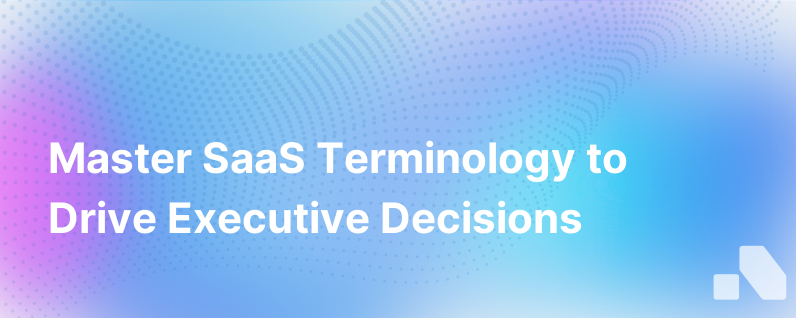Saas Terminology
Published on August 17, 2023 by David Zhang
Software-as-a-Service (SaaS) has revolutionized the way we use technology in business - offering accessible, scalable, and cost-effective software solutions. As its influence grows, so does the lexicon of terms around it. Understanding this terminology is crucial for anyone working within, or doing business with, the SaaS industry. In this piece, we delve deep into the key SaaS terms that you need to know.
Key SaaS Terms Explained
1. SaaS (Software-as-a-Service)
This is a cloud-based service where instead of downloading software to your business’s physical computers or servers, you access an application via an internet browser. The software application could range from anything like email, office software, or even more complex business applications such as CRM or ERP systems.
2. Cloud Computing
Cloud computing denotes the on-demand availability of computer system resources, especially data storage and computing power, without direct active management by the user. It encompasses anything that involves delivering hosted services over the internet, including SaaS.
3. Subscription Model
In contrast to traditional software's one-time purchase, SaaS operates primarily on a subscription model, where users pay a recurring fee, usually monthly or annually, to use the software.
4. MRR (Monthly Recurring Revenue)
A crucial metric for SaaS businesses, MRR is the predictable revenue that a company can expect on a monthly basis from all active subscriptions.
5. ARR (Annual Recurring Revenue)
As with MRR, ARR calculates the expected yearly revenue from customer subscriptions. It's an essential metric for gauging long-term financial health.
6. Churn Rate
Churn rate is the percentage rate at which customers cancel their recurring revenue subscriptions. It's a vital sign of customer satisfaction and product-market fit in a SaaS business.
7. CAC (Customer Acquisition Cost)
CAC is the average cost to acquire a customer, including all sales and marketing efforts. It’s critical for assessing the investment needed to expand the customer base.
8. LTV (Lifetime Value)
LTV estimates the total revenue a business can expect from a single customer account throughout the business relationship. It's a predictive measure used to inform decisions on customer acquisition and retention.
9. Freemium
A business model wherein basic services are provided free of charge, while additional features (premium) are available for a cost. It's a popular SaaS strategy to attract users with the hope of converting them into paying customers.
10. Upselling
This sales tactic involves encouraging customers to purchase a more expensive version of a product or add-on features that reflect higher value.
11. API (Application Programming Interface)
APIs allow different software systems to communicate with each other. They enable integration of third-party services and capabilities into the core SaaS offering.
12. Onboarding
The process of getting new users acquainted and comfortable with a SaaS product. It often encompasses tutorials, training sessions, and customer support.
13. Vertical SaaS
SaaS products designed for specific industries (e.g., healthcare, real estate, finance). Vertical SaaS solutions are tailored to the particular needs and workflows of specialist users.
14. Horizontal SaaS
These are SaaS products which cater to a wide range of industries, offering solutions for functions common across industries such as email, accounting, or customer relationship management.
15. SLA (Service Level Agreement)
This contract between a service provider and the end user defines the level of service expected from the SaaS provider – including uptime, privacy, security standards, and what compensation is offered if these aren't met.
16. IaaS (Infrastructure as a Service)
A form of cloud computing that provides virtualized computing resources over the internet, often seen as the backbone upon which SaaS can operate.
17. PaaS (Platform as a Service)
This cloud computing model delivers a framework for developers that they can build upon and use to create customized applications.
18. ACV (Annual Contract Value)
ACV is a measure of the value of a contract over a year. For SaaS companies with annual or multi-year subscription agreements, it’s used to assess the business’s performance.
19. Customer Success
This term refers to the function within a SaaS organization that focuses on the relationship with the customer, ensuring they achieve their desired outcomes while using the product. It goes beyond customer service by proactively guiding customers to receive more value from the SaaS offering.
20. Public Cloud
A cloud environment typically owned by a third-party cloud service provider that delivers resources like servers and storage over the internet. SaaS is commonly deployed within public clouds.
21. Private Cloud
A proprietary computing architecture that offers hosted services to a limited number of people behind a firewall, increasing security. Often used by larger enterprises with stringent data requirements.
22. Hybrid Cloud
A cloud computing environment that uses a mix of on-premises, private cloud, and third-party, public cloud services with orchestration between the two platforms, usually to provide greater flexibility and more data deployment options.
23. User Activation
A metric for SaaS businesses, tracking the stage a new sign-up becomes a "user" to whom the firm can realistically expect to deliver value.
24. Customer Onboarding
The process after a purchase has been completed, characterized by welcome emails, training sessions, product walkthroughs, and any additional resources to help customers start effectively using the software.
25. Net Negative Churn
This occurs when the revenue from existing customers (through upsells, cross-sells, and upgrades) exceeds revenue lost from churned customers.
26. Expansion Revenue
Income that comes from existing customers through upselling or cross-selling. This revenue indicates customer satisfaction and product uptake.
In sum, these terminologies represent the operational, financial, and strategic facets of the complex and multifaceted ecosystem that is SaaS. Whether you're running a startup or leading a high-performing sales team, knowing the language will enhance communication, streamline processes, and help navigate the SaaS landscape with more acuity.